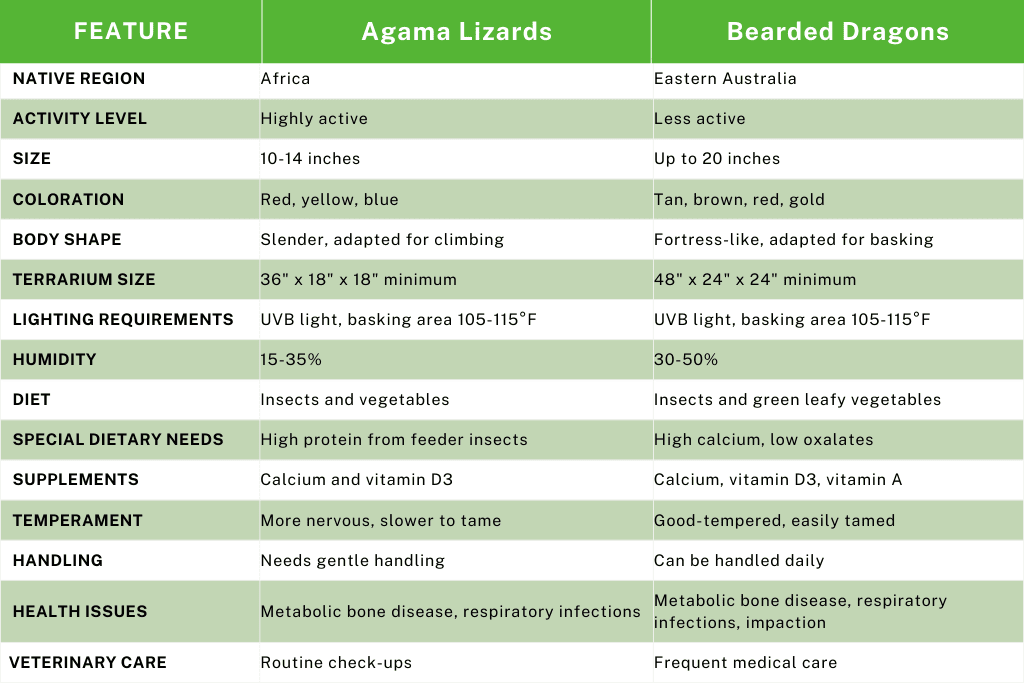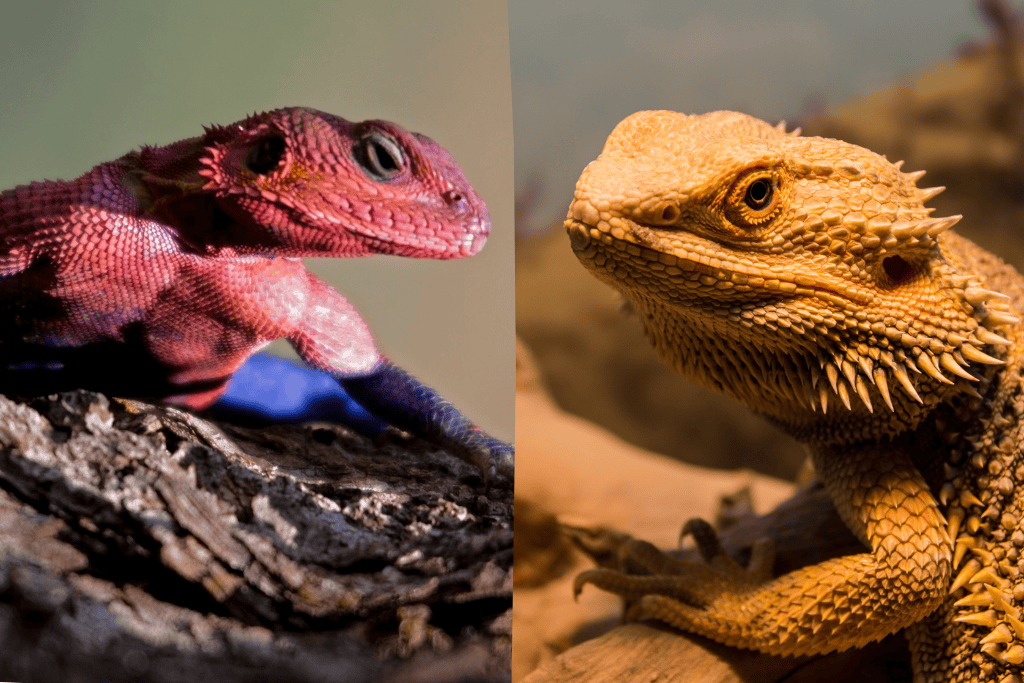Two of the most common available species of lizards are painted agama and bearded dragons but they are not the same. Agamas are smaller moving lizards indigenous to Africa and these need high vertical terrariums, UVB lamps for exposure to light, a hot side for basking and a diet that includes insects and vegetables only.
Bearded dragons are naturally occurring in eastern regions of Australia. They are less active and relatively bigger lizards which require larger space with a heat lamp, UVB light, and a range of lettuce and other green leaves with the feeder insects.
They are both sociable animals and can be easily tamed but their tanks, lighting, feeding, and stimulation requirements are dissimilar due to their origins and inclinations. Knowing the difference in these classifications assists in the proper handling and care of the reptiles and also in fashioning the versatility of reptiles as pets.

Physical Characteristics and Appearance
Bearded dragons and painted agamas are two lizard species from the Agamidae family that are often traded in markets. Bearded dragons belonging to eastern Australia exhibit tan, brown, red and gold coloration while the painted agamas display red, yellow and blue coloration.
Color and Pattern Differences
Coloration is less contrasting than that of painted agamas used during courtship and exhibits reds, yellows and blues that are not as bright.Fortress-like body with bearded dragons is suitable for their basking postures as opposed to the more slender body of painted agamas which assist them in climbing.
Size and Body Shape Differences
The size difference and body shape of painted agamas and bearded dragons are obvious.
Adult bearded dragons can grow up to 20 inches and are considered one of the largest lizards to be kept as pets while painted agamas will only grow to be around 10-14 inches long at most.
It helps to know that these two species of reptiles are different, this way reptile enthusiasts can provide them with the environment and care they require. It is important to have proper housing, lighting, heat, proper diet exercise and play for their overall wellbeing.
Blue Agama Lizard
Habitat and Environmental Requirements
Agama painted and bearded dragons are originally from arid, rocky habitats and all like to bask. Painted Agamas are native to Africa and the Middle East while bearded dragons are native to eastern parts of Australia. These different species have been known to be thermophilous and live in natural habitats that are characterized by hot and dry conditions with adequate basking grounds.
Terrarium Size and Setup
When it comes to painted agama terrarium, one painted agama can live comfortably in a cage that bare minimum measures 36 inches long, 18 inches wide, and 18 inches tall while bearded dragons are significantly bigger than painted agamas and need more space – a cage that measures at least 48 inches by 24 inches by 24 inches.
Both require a dry surface and stable shelter and warming zones for both night and day. Painted agama males can fight in one house with multiple males and therefore each male should have its enclosure.
Lighting and Temperature Requirements
They require proper lighting and heating because appropriate lighting is essential to providing the proper temperature. They require a warm zone for basking between 105-115 degrees F, plus a UVB bulb for 10-12 hours per day.
Nighttime brings minimum temperatures of 70 – 85°F to the area. Painted agamas should be kept in a comparatively dry environment, at a humidity of 15-35%, while bearded dragons prefer more humid conditions at 30-50%.
A good brand of UVB bulbs is essential. Different types of bulbs: The “night time” bulbs or the red bulbs should not be used as they can disrupt their natural day-night cycle aside from not being able to provide the right heat requirements.
Diet and Nutrition
Omnivorous Diet Comparison
The bearded dragon and painted agama species of agamid lizards on the whole are omnivores meaning they must be fed with both plant and animal matter to be healthy.
Bearded dragons, belonging to the genus Pogona and situated in the eastern part of Australia, should be fed on a diet containing high amounts of calcium and low oxalates with a special preference to green leafed vegetables such as collard greens and mustard greens that aid in promoting bone development.
Stared agama or painted agamas, should be fed on a diet that is high in protein and feeder insects such as dubias, discoids, and crickets for them to remain active.
Supplements and Vitamins
Both bearded dragon and painted agama species must be provided with correct calcium and vitamin D3 to enable the development of healthy bones.
Also, feeding bearded dragons may warrant supplementation with additional vitamins such as vitamin A and carotenoids like beta-carotene to boost their immune systems. Both species also require proper UVB lighting for their survival.
Bearded Dragons
Behavior and Handling Comparison
Temperament and Socialization Differences
Bearded dragons, Pogona vitticeps, belong to the Agamidae family of lizards native to Australia’s eastern region and are good-tempered inland bearded dragons that can easily adapt to being handled as pets compared to other lizard species.
Still, painted agamas, or other forms of agamid lizards including rough tail rock agama or the clown agama are likely to become more stressed and frightened when caged with painted dragons and may take longer periods of taming and acclimatization to their tamer.
The two kinds of lizards, whether it is the bearded dragon or the painted agamas, can have the possibility of being tamed in the presence of cautious and regular handling procedures accompanied by positive reinforcement to make the reptiles familiar with the presence of their caretakers and friendly to them as well.
An appropriate environment including huge safe heaps or a high cage for an active tree dwelling painted agama is required as well.
Handling and Taming Comparison
Bearded dragons are more amicable to daily handling by their owners and once habituated to human hands, can be released to roam the house safely apart from their main terrarium without signs of discomfort.
Painted agamas are more likely to be more nervous by their temperament so they should not be handled roughly or for long periods and the handler should retrain his/her movements to be slower and not to scare the lizard.
An agama which is normally encountered might still be quite shy compared to other kept bearded dragons even if it was a single painted agama painted being handled daily or a group of painted agamas being kept together.
Of the two, the Bengal cat can be a good companion as a pet, although the care that they need differs from those of the other species and of course close supervision is essential.
Care and Health Considerations
Common Health Issues and Prevention
The first is the inland bearded dragon (Pogona vitticeps) from Eastern Australia and the second is the painted agama (Laudakia stellio), also referred to as the starred agama or painted dragon and both of these species can suffer from metabolic bone disease, respiratory infections, and impaction if the conditions are not met.
As for husbandry for this breed of lizards, proper lighting using UVB light, foods rich in calcium and vitamin supplements, such as green leaves and vegetables, and a clean environment are key in avoiding sickness and disease. It is also suggested to take the exotic animal to a veterinarian to look for any health problems.
Veterinary Care and Maintenance
Like most reptile pets, both the inland bearded dragon and painted agama need to be taken to the vet for routine check-ups, to ensure that they do not get ill, nor develop diseases such as metabolic bone disease and other ailments that may affect their health.
The bearded dragons will frequently need medical care as well as husbandry intervention because of their size and some of the issues such as improper handling by people, housing, and basic feeding schedules.
To avoid health issues in both species, proper UVB lighting with the right bulbs in use, maintaining of basking surface temperature to about 105 °F, feeding the animals with a variety of insects and fresh plant matters and lastly; maintaining clean habitats are some of the ways.
Frequently Asked Questions
What is the main difference between a bearded dragon and an agama?
It is crucial to note that agamas and bearded dragons are two different species of lizards. Bearded dragons originate from Australia. Thus painted agamas are from Africa. It is obvious that they have different behavior and require varying levels of attention.
Which is a better pet, an agama or a bearded dragon?
The decision of which one to get between an iguana and a bearded dragon is based on your preference. In general, they are believed to be more suitable for beginners because of their smaller size, friendly temperament, and need for less maintenance.
Are agama lizards good pets?
Agama lizards are among the best types of reptiles that can be kept at home. These can very well be tamed and managed rather easily but they do need a large cage and the correct temperature and high humidity. It is necessary to throw light on the definite needs of the certain agama species that you are going to get.
Are painted agamas friendly?
Natural behaviors of captive painted agamas are not aggressive and despite their small size, they can tame down on regular handling. But they are not as friendly as bearded dragons and can be easily frightened, therefore not so appropriate for families with kids or those who would like to handle their pets often.




